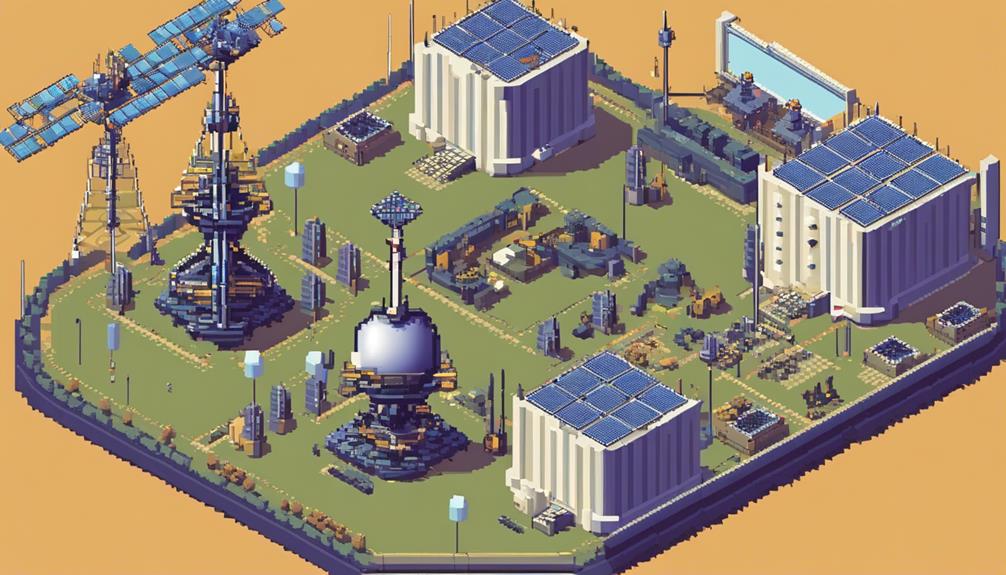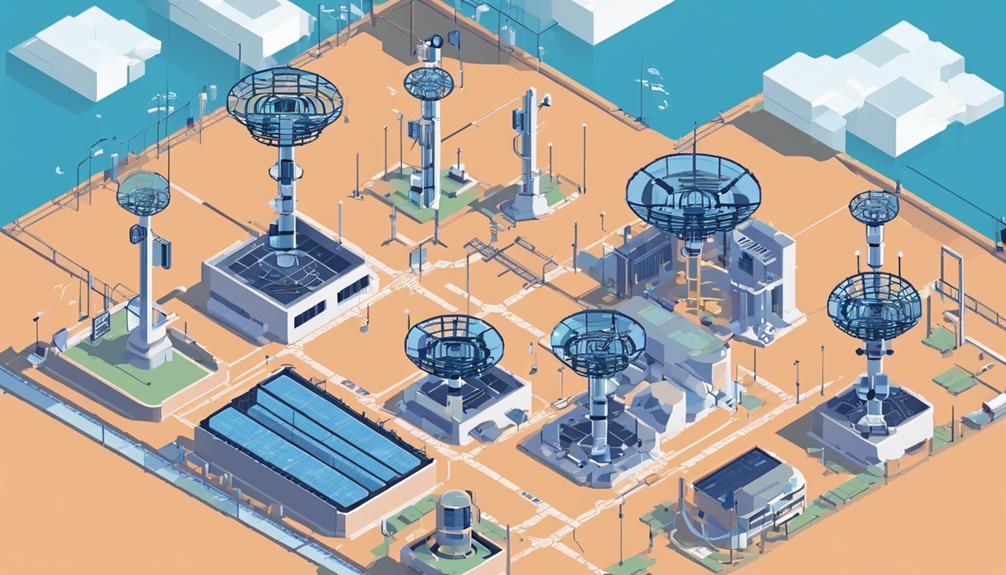The landscape of ground station technology is witnessing a profound transformation, with key advancements propelling the efficiency and security of satellite communication systems to new heights. From Quantum communication ensuring data integrity to the implementation of Phased-array antennas for enhanced satellite connectivity, the evolution in ground station technology is redefining industry standards. With Artificial Intelligence streamlining operations and the integration of laser communication bolstering security measures, these innovations are not only reshaping current practices but also hinting at a future where ground stations will play an even more pivotal role in the realm of satellite communications.
Key Takeaways
- Phased array antennas enhance signal quality and reduce interference.
- Software-Defined Ground Stations offer flexibility and scalability.
- Cloud-based infrastructure integrates automation for efficient satellite data processing.
- AI applications improve operations and cybersecurity measures safeguard data transmission.
Evolution of Ground Stations

In the realm of satellite communication infrastructure, the evolution of ground stations has been marked by a transition from rudimentary antennas to complex communication centers boasting cutting-edge tracking capabilities. Advancements in ground stations have revolutionized the way communication with satellites is facilitated. Originally serving as basic signal reception points, ground stations have transformed into sophisticated hubs equipped with state-of-the-art technology to handle various aspects of satellite communication systems.
The evolution of ground infrastructure has been significant, with the integration of technologies such as Machine Learning algorithms, Automation, and Artificial Intelligence (AI) to enhance overall system efficiency. One notable development is the utilization of phased array antennas that allow for dynamic beam steering, enabling better tracking of satellites as they orbit the Earth. These advancements have streamlined communication processes, improving the reliability and speed of data transmission between ground stations and satellites.
Furthermore, the introduction of Software-Defined Ground Stations (SDGS) has played a pivotal role in shaping the evolution of ground stations. SDGS offer unparalleled flexibility by allowing for easy reconfiguration to adapt to different satellite systems, resulting in cost-efficiency and scalability in ground station operations. This adaptability has transformed ground stations into versatile communication centers capable of efficiently managing a wide range of satellite communication tasks.
Software-Defined Ground Stations
Software-Defined Ground Stations (SDGS) revolutionize ground station operations through their adaptability and reprogrammable nature. This innovation paves the way for enhanced flexibility in satellite communication systems while simultaneously streamlining data processing. By eliminating the dependence on specialized hardware and enabling remote control, SDGS offer a cost-effective and versatile solution for satellite operators.
Flexibility in Operation
How can modern ground station technology adapt seamlessly to changing satellite communication needs while maintaining operational efficiency and flexibility? Software-Defined Ground Stations offer a solution through reprogrammable software, enabling support for multiple communication frequency bands and rapid adoption of new communication protocols without requiring hardware modifications. The scalability of these stations allows for dynamic resource allocation, ensuring efficient utilization of resources. Remote control capabilities and the ability to reconfigure the ground stations remotely contribute to their adaptability to varying operational requirements. Furthermore, the shared usage feature facilitates collaboration between different satellite operators, enhancing overall operational efficiency. In essence, Software-Defined Ground Stations provide the flexibility needed to meet the evolving demands of satellite communication while optimizing resource usage and operational effectiveness.
Improved Data Processing
Ground stations equipped with software-defined technology revolutionize data processing capabilities by seamlessly integrating advanced signal processing techniques for enhanced data quality and operational efficiency. Software-Defined Ground Stations (SDGS) play a crucial role in improving data processing capabilities by dynamically allocating spectrum resources, facilitating remote control, and enabling shared usage among multiple satellite operators. SDGS offer scalability, quick adaptation to new communication protocols, and easy integration of signal processing techniques, reducing overall operational costs. By eliminating the need for extensive hardware, these ground stations enhance flexibility and adaptability in handling satellite communications, ultimately enhancing operational capabilities.
| Software-Defined Ground Stations Features | Benefits |
|---|---|
| Reprogrammable software for multiple bands | Scalability |
| Quick adaptation to new protocols | Reduced costs |
| Advanced signal processing integration | Enhanced data quality |
| Dynamically allocate spectrum resources | Improved efficiency |
Advanced Antenna Systems

Advanced Antenna Systems, including phased-array antennas and beamforming technology, play a crucial role in enhancing signal reception and transmission capabilities in ground stations. Phased-array antennas offer dynamic beam adjustments, ensuring improved signal quality and efficient communication with multiple satellites simultaneously. Additionally, beamforming technology within antenna arrays reduces interference and boosts signal strength, providing cost-effective and resilient solutions for satellite communication needs.
Beamforming Technology Overview
Utilizing advanced antenna arrays, beamforming technology employed in ground stations enhances signal strength and minimizes interference by directing energy towards specific directions. This technology offers several advantages in satellite communication:
- Operational Efficiency: Antenna arrays enable ground stations to handle multiple tasks simultaneously, increasing overall operational efficiency.
- Resilience: Beamforming technology provides redundancy, ensuring continuous communication capability even in case of failures.
- Dynamic Beam Adjustments: Ground stations can dynamically adjust beams to track and communicate with multiple satellites, enhancing system flexibility.
- Cost-Effective: Beamforming technology is a cost-effective solution for ground stations, improving signal quality and reliability in satellite data transmission.
Benefits of Phased Arrays
Phased arrays revolutionize ground station communications by enhancing signal strength and reducing interference through advanced antenna systems. These systems enable efficient tracking and communication with multiple satellites simultaneously, ensuring reliable data transmission. Phased arrays offer redundancy, guaranteeing uninterrupted communication even during system failures. Their cost-effectiveness makes them a preferred technology for ground stations, providing scalability and flexibility in operations. The dynamic beam adjustments possible with phased arrays significantly enhance signal quality, improving communication capacity and overall efficiency. By incorporating advanced antenna systems like phased arrays, ground stations can optimize their communication networks, ensuring robust and reliable data exchange with satellites.
Improved Signal Reception
Enhancing signal reception capabilities for ground station communications, advanced antenna systems like phased array antennas play a crucial role in optimizing satellite data transmission.
- Dynamic Beam Adjustments: Phased array antennas enable real-time adjustments of signal beams, ensuring enhanced signal quality.
- Faster Tracking: These advanced antennas provide rapid tracking and pointing capabilities, facilitating efficient satellite communication.
- Communication with Multiple Satellites: Ground stations can establish simultaneous communication links with multiple satellites using phased array antennas.
- Enhanced Communication Capacity and Signal Reliability: The utilization of advanced antenna systems results in increased communication capacity and improved signal reliability for ground station technology.
Cloud-Based Infrastructure

Leveraging cloud computing technology, cloud-based ground station infrastructure revolutionizes satellite data processing and management by eliminating the need for extensive on-premises hardware. This innovative approach offers efficient satellite data processing, enabling satellite operators to scale their operations seamlessly. Scalability is a significant advantage, allowing for capacity expansion during peak demand without the burden of additional hardware investments. By migrating to cloud-based infrastructure, satellite operators can reduce hardware costs significantly while enhancing operational efficiency.
Moreover, cloud-based solutions provide flexible options for managing satellite communication and data processing. The versatility of cloud computing enables satellite operators to adapt to changing requirements swiftly and cost-effectively. Additionally, the cloud-based infrastructure offers a more streamlined and dynamic approach to handling satellite data, ensuring that operations run smoothly and effectively.
Automation Integration
Ground station operations are increasingly benefiting from the integration of automation, particularly through the utilization of AI algorithms to streamline tasks and enhance overall performance. This fusion of technology brings about significant advancements in satellite communication. Here are four key aspects of automation integration in ground stations:
- Real-Time Decision-Making: AI algorithms enable swift data analysis, facilitating quick decision-making processes within ground stations, ensuring efficient satellite operations.
- Anomaly Detection: The anomaly detection capabilities of AI algorithms minimize downtime by promptly identifying and addressing issues, ensuring continuous communication and uninterrupted services.
- Proactive Monitoring: Automation integration allows for proactive monitoring and maintenance tasks, preemptively addressing potential problems to optimize system performance and reliability.
- Signal Detection and Interference Mitigation: Advanced automation and AI technology enhance signal detection accuracy while effectively mitigating interference, ensuring high-quality communication links for seamless satellite operations.
The integration of automation and AI in ground stations not only simplifies routine tasks but also enables sophisticated capabilities such as real-time decision-making, anomaly detection, proactive monitoring, and signal optimization, ultimately enhancing system performance and overall operational efficiency.
Artificial Intelligence Applications

The implementation of artificial intelligence in ground station technology revolutionizes satellite communication operations through advanced automation and data analysis capabilities. AI algorithms play a crucial role in streamlining ground station tasks, automating satellite tracking, and enhancing data analysis processes. Anomaly detection using AI ensures the continuous and reliable operation of satellite communication systems by minimizing downtime and promptly addressing issues. Machine learning algorithms further contribute to improving signal processing, enhancing security measures, and optimizing resource allocation within ground stations. These AI-enabled systems efficiently handle complex tasks such as spectrum monitoring and interference mitigation, boosting operational efficiency significantly.
To emphasize the benefits of artificial intelligence applications in ground stations, the following table illustrates key areas where AI plays a pivotal role:
| AI Applications | Description | Benefits |
|---|---|---|
| Automation | Streamlines routine tasks | Increases operational efficiency |
| Anomaly Detection | Identifies and addresses irregularities | Minimizes downtime and ensures reliability |
| Machine Learning | Enhances signal processing, security, and resource allocation | Optimizes satellite communication operations |
The incorporation of AI in ground station technology not only enhances operational efficiency but also enables proactive monitoring and maintenance, paving the way for a more robust and reliable satellite communication infrastructure.
Cybersecurity Measures
How can cybersecurity measures fortify the integrity and resilience of satellite communication operations within ground station technology? To ensure the safeguarding of ground station operations against evolving cyber threats, advanced cybersecurity measures are paramount. Here are four key strategies that contribute to enhancing the cybersecurity posture of ground station technology:
- Implementation of Secure Network Protocols: By enforcing secure network protocols, such as Transport Layer Security (TLS) or Virtual Private Networks (VPNs), data transmitted between ground stations and satellites remain encrypted and protected from unauthorized access.
- Utilization of Encryption Protocols: Encrypting data both at rest and in transit using robust encryption algorithms adds an extra layer of security, preventing sensitive information from being compromised even if intercepted.
- Deployment of Intrusion Detection Systems: Intrusion detection systems continuously monitor network traffic for any suspicious activity or unauthorized access attempts, triggering alerts for immediate investigation and mitigation.
- Integration of Anomaly Detection Algorithms: Anomaly detection algorithms help in identifying unusual patterns or behaviors within the network that deviate from normal operations, enabling early detection of potential cybersecurity threats before they escalate.
Optical Ground Stations

To fortify the integrity and resilience of satellite communication operations within ground station technology, the utilization of optical ground stations emerges as a pivotal advancement in ensuring secure and high-speed data transmission. Optical ground stations leverage laser communication technology to facilitate secure and rapid data transfer between ground stations and satellites in orbit. One of the key advantages of optical ground stations is their immunity to radio frequency interference, which ensures a reliable and uninterrupted communication link essential for satellite operations.
These advanced ground stations enable data transfer rates of up to several gigabits per second, significantly surpassing traditional radio frequency communication systems. By establishing secure communication links with satellites, optical ground stations play a critical role in enhancing data security and reducing signal latency in satellite communication networks. The continuous advancements in optical ground station technology contribute to improved operational efficiency and reliability in satellite communication systems, making them indispensable components of modern space communication infrastructure. Overall, optical ground stations represent a cutting-edge solution for addressing the challenges associated with high-speed data transmission, data security, and signal latency in satellite communication, paving the way for enhanced performance and resilience in space-based operations.
Enhanced Operational Efficiency
Enhancing operational efficiency in ground stations involves integrating automation, AI technologies, and advanced signal processing capabilities to optimize satellite communication processes. This integration leads to a more streamlined and effective system. Here are four key components that contribute to enhanced operational efficiency in ground stations:
- Automation and AI Integration: By automating routine tasks and integrating AI algorithms, ground stations can reduce human intervention, minimize errors, and accelerate processes, ultimately enhancing operational efficiency.
- Software-Defined Ground Stations: These stations offer a cost-effective solution by eliminating the need for expensive proprietary hardware. They provide flexibility and scalability, leading to improved operational efficiency.
- Antenna Arrays and Beamforming: Utilizing antenna arrays enables beamforming, which enhances signal strength, reduces interference, and improves overall communication quality, thus contributing to operational efficiency.
- Signal Processing and Dynamic Spectrum Allocation: Advanced signal processing capabilities combined with dynamic spectrum allocation techniques optimize resource utilization and enhance operational processes, ensuring efficient communication and data transmission in real-time decision-making scenarios.
Frequently Asked Questions
What Are the Advancements in Satellite Technology?
Advancements in satellite technology encompass a range of innovations. Satellite constellations, comprising miniature satellites, enhance high-speed data capabilities for remote sensing applications. Inter-satellite links enable seamless communication, bolstered by artificial intelligence for autonomous operations. Addressing challenges like space debris, quantum communication ensures secure data transmission. Integration of solar power and 5G technology further propel the evolution of satellite systems towards enhanced functionality and efficiency.
What Is the Newest Satellite Technology?
The newest advancements in satellite technology encompass various facets, including satellite tracking, navigation, imaging, communication, telemetry, networking, control, reception, data, and monitoring. Innovations in satellite technology are driving progress in these areas, shaping the future of space exploration and communication. By leveraging cutting-edge technologies and methodologies, satellites are becoming more efficient, secure, and versatile in fulfilling their designated functions across a wide range of applications.
What Is the Earth Station Technology?
Earth station technology, also known as earth stations, encompass ground systems equipped with antennas, receivers, and transmitters for satellite communication. These stations facilitate signal reception, data processing, and communication protocols for transmitting data to and from satellites. They are vital components of network infrastructure, enabling remote operations and system integration. Earth station technology plays a crucial role in ensuring seamless satellite coverage worldwide through strategic placement and advanced antenna design.
What Are the Future Trends of Satellite Communication?
The future trends of satellite communication will encompass advancements in quantum communication, deployment of satellites in low Earth orbit for improved connectivity, integration of 5G technology, establishment of inter-satellite links, addressing challenges of space debris, utilization of cloud computing for data processing, implementation of artificial intelligence for optimizing operations, ensuring global coverage, enhancing data security measures, and fostering the development of autonomous systems to streamline satellite operations efficiently.
